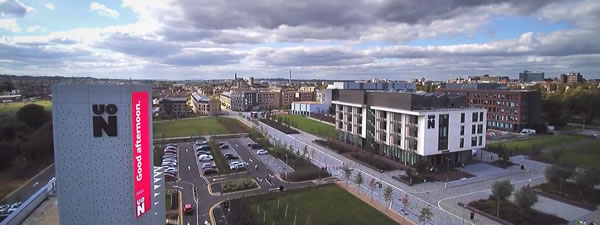The University of Northampton moved to a new purpose-built campus on September 2018, the successful conclusion of a demanding project. It was decided from the outset that the new campus should provide the best rather than the cheapest way of teaching students.
This led to the creation of an ideal environment for small group teaching and active learning. But how do teachers respond when the barriers to active learning are removed?
We put this and other questions to Rob Farmer, currently the University’s Learning Technology Manager, who worked as part of a team of learning designers during the lead up to the campus move, helping academic staff (re)design their modules and courses to take full advantage of the active, technology-enabled learning opportunities that the new campus would bring.

Why was this project important?
Arguably the move from two University sites to a single purpose-built one was the biggest thing to happen to the University in its history. It gave us a great opportunity to really think about the type of teaching we wanted to do, and about the type of University that we wanted to be.
It would have been very easy to build a new university full of lecture theatres, but the University decided that our teaching would be far more effective if we focused on small group teaching and active learning – a far more preferable pedagogical solution.
The University asked the question, ‘What is the best way of teaching?’ Then designed and built a campus to support it.
What happened when the barriers to active learning were removed?
The University worked hard to engage with both staff and students. There were many roadshows, workshops, and other opportunities to ask questions. The learning designers, in particular, worked with individual academics, supporting them to adapt, re-purpose and re-design courses, modules, and teaching content.
Of course, it is essential to note that we adopted active learning and small group teaching as it is good pedagogy, not simply because we were moving to the Waterside campus.
The impact on teachers is entirely dependent on who you talk to.
For some, the transition has gone almost seamlessly with few significant changes. We are lucky at the University of Northampton in that we already had many teachers who were already switched on to active learning and small group teaching. Now they still work with groups of 20-30 students but in a much nicer and more practical environment.
For others, though, the move has been more transformational. Previously, although many teachers may have wanted to adopt a more active approach to learning, this was difficult if they were timetabled to teach in large lecture theatres. Course content is still vitally important – students still have to know things, of course – but there are far more opportunities now for small group teaching and for students to put their knowledge to work, and this has been extremely well-received by both staff and students.
What was the secret of your success?
There are several:
- Starting with the right question – what is the best way of teaching
- Support for academics – learning designers worked closely with many scholars during the lead up to the campus move and afterward, and each academic department has always had a learning technologist aligned to it, so every faculty member knows who to talk
- We have been involved with technology-enabled learning well in advance of the move to the new campus, so the learning technology side of things didn’t come as a shock to anyone as all staff and students have been using the University’s digital learning environment for many
What were the benefits?
Even the skeptics like the new Waterside campus more than they expected to. It is awe-inspiring, well designed, and very green. It looks modern, and it is in a great location – very close to the town’s cultural quarter with its theatres, arthouse cinema, museum, art gallery, etc., but also with the river, parks, historic buildings, and sites of historical interest on the doorstep.
This has had an impact on both staff and students. Some new academics that we have spoken to cited our commitment to active learning and small group teaching as the reason why they wanted to teach here.
There is another angle to this as well. All universities struggle to find their USP. But Northampton’s USP is much more visible now as you walk around the campus, with its commitment to active, small group, technology-enabled teaching and learning clearly on display all around the campus. It’s a real twenty-first- century campus.
What were the challenges?
Many people think the main challenge will be to get academics to change their approach to teaching; this has not been our experience.
Our primary battle has been to get staff to understand some of the nuances of technology-enabled learning. Misconceptions were sometimes evident. Some people think technology-enabled education means that everything should be online when it’s not about this at all, or that it is a considerable departure from business as usual. We’re still a campus-based university, and most of our teaching takes place with academics and students in classrooms. In the end, many of the academics we worked with were much closer to the University’s vision of active, small group, technology-enabled learning than they thought, and in some cases, we even found ourselves trying to persuade academics to do less online.
What are your top tips for others?
- Focus on what’s important – the student experience – and build your approach to learning and teaching around this.
- Be mindful of what educational research tells us are effective approaches to teaching and
- Provide academic staff with plenty of support, in the form of learning designers, learning technologists and content developers, but make sure that they focus on helping and supporting academics to do what they want to do in the best way possible, rather than trying to push a clumsy ‘one-size-fits-all’ approach to teaching and learning.
- Build close relationships with the people you support (this has worked very well for us).
- Take the time to explain your pedagogical model to students. If you’re doing something unexpected or innovative, explain to your students why they’ll learn better using this
What does the future hold for EdTech?
There are a number of exciting developments. Significant growth in apprenticeships in the UK will be necessary. The use of electronic portfolios will expand further and become more critical for apprenticeships and others who need to blend work and study. Portfolio systems can be very good at turning the whole world into a classroom, and students can see learning opportunities everywhere.
Several departments, particularly medicine and healthcare, are exploring exciting developments in virtual and augmented reality (VR and AR). It is very exciting work and as the quality of simulations keeps improving, the results are quite remarkable.
The University of Northampton is a Barco case study.
Ready to discover how technology can enable you to flip the classroom and help you achieve better learning outcomes?
Join our webinar
What you will learn:
The flipped classroom is an active learning approach in which the learning is student-centred rather than teacher-centred. During this webinar, a Barco Representative will share with you his in-field expertise they have built up during his extensive discussions with deans and head of new learning on how to start with technology enhanced learning: what are their challenges, how they overcome them and how technology is enabling them to flip the classroom.
Save your spot at: https://www.barco.com/en/page/wepresent-webinar
- Active learning without the barriers – how teachers respond - November 5, 2019

